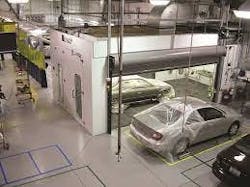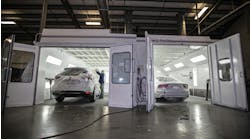Dealership shop operator believes in need for consistency, sticking with the repair plan
In a previous column, I wrote about some of the thoughts Mike Giarrizzo recently shared with me related to his company’s beliefs, practices and predictions. Mike has had a long, successful career in this industry, including as CEO of DCR Systems, which currently operates eight collision repair shops in four states in partnerships with auto dealers. He sees the business model he began developing back in 2005 as being ideally suited to how the industry has evolved.
“We truly believe we can create a network of OEM-guided dealer-based collision centers that actually serve the franchise and serve the customer with certified repairs,” Giarrizzo said.
Here are a few more of his thoughts that I think are relevant to share with the industry.
Non-DRP doesn’t mean anti-insurance. “We’re not anti-insurance by any means. We just don’t participate in the DRP world. We don’t feel the stars are aligned properly there,” Mike said. “In that world, we don’t believe that everybody’s needs are being met. Only some of the stakeholder’s needs are being met. The one that’s left out in a lot of cases, unfortunately, is the vehicle owner. We see that all the time. It doesn’t mean [anyone is] intending to put out faulty repairs or repairs that aren’t correct. It’s just in a traditional world with commission-based technicians, they’re essentially subcontractors. It’s virtually impossible to put an extreme level of oversight on those repairs. We see it time and time again.”
Consistent repair methods ensure consistent outcomes. When DCR Systems determines a best practice related to repairs – such as the use of roll-on primers or no longer edging parts – it ensures that that practice is being used consistently throughout the organization.
Every car gets measured, for example.
“If we’re taking a part off the car, if we’re only putting a bumper cover on, we’re measuring the car,” he said. “We feel very strongly about that. It’s no different than if you go to the doctor with a swollen arm, the first thing they will do is X-ray it.”
More recently the company halted the use of welded tabs and has gone to all cold repair.
“I’ve seen the integrity of too much metal destroyed,” Mike told me. “When you’re welding a stud on there and pulling it out and cutting it off, you’re destroying the integrity of the metal. So if we can’t glue-pull it to the point of minor fill, then the panel needs to be replaced.”
You can negotiate on price but not on the repair plan. Mike views the work order, the repair plan, like an architect’s blueprint. It’s how the building will be built, or how the car will be repaired. You can’t deviate from that. They have the training from the OEMs and the documentation to back that up.
“That changed the way we started going after settling claims,” Mike told me. “We’ve taken a respectful approach that if you want to discuss methodology, if you want to challenge our methodology, we’ll talk about that and give you back information about why we’ve chosen that. But this repair plan, from a content standpoint, is not negotiable. We’re going to fix the car this way and invoice it this way. That doesn’t mean we won’t make a reasonable concession on behalf of the customer, but that has to be reasonable. That’s not 30 percent off a $4,000 claim.”
That means a DCR shop doesn’t have to be concerned with what some insurer’s guidelines are, what they can or can’t write.
“You still have the companies trying to drag you into that line item discussion,” he said. But for the most part it’s really been a game-changer. Now most of the time we’re making a one-line adjustment, like, ‘Minus $136 to obtain a reasonable settlement on behalf of the customer.’”
I’ll share a final few concepts from my conversation with Mike in a future column.





